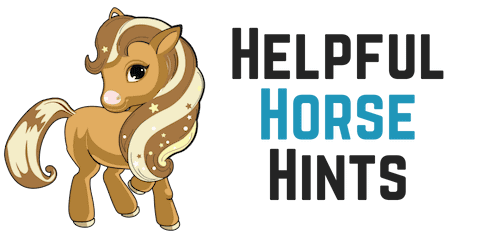Dressage is an Olympic sport in which a rider trains a horse to perform specific maneuvers that test the horse’s strength, agility, and balance. It’s often called an art because it takes many years to learn, and many more to master. Dressage levels are the steps of progression a horse and rider progress through as they develop more dressage concepts and movements.
Riders and their horses ascend through levels of dressage, starting from Novice, and eventually ascending to competitions such as the intermediate Prix St. Georges competitions that filter advanced riders into the Grand Prix.
As horses move through their training in dressage, they perform tests in competition that measure their progress. Each level increases in difficulty, with new concepts and movements and training. Both horse and rider should have a good mastery of the skills at their current level before moving to the next.
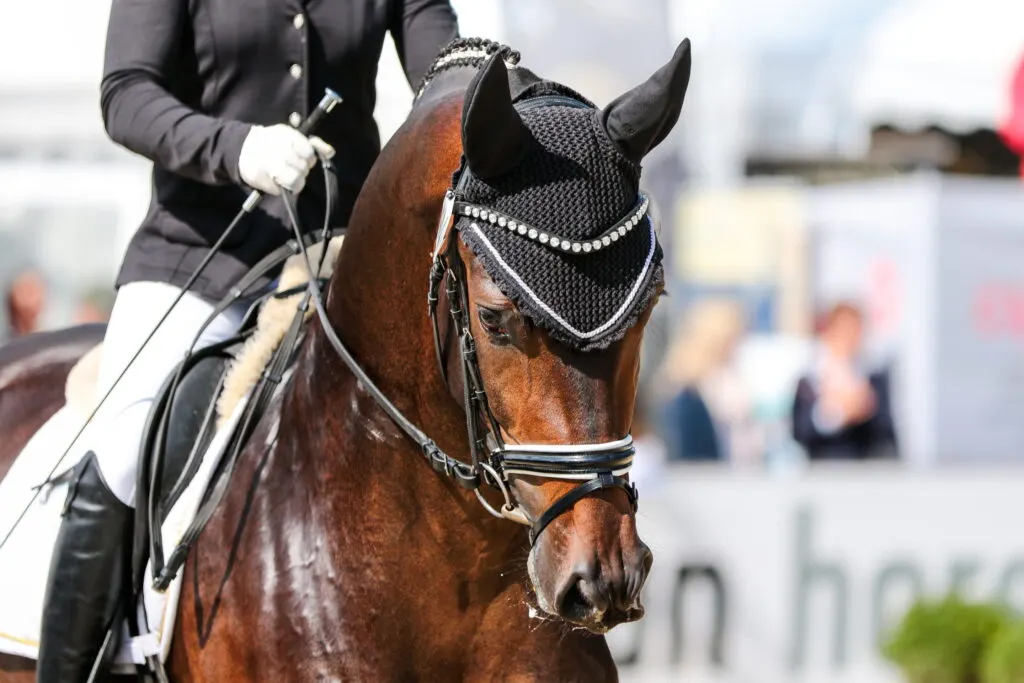
Table of Contents
US Dressage Levels Explained
As horses and riders progress through their training together and receive high scores in competition, they can add maneuvers to their skill sets and move up to new levels.
The levels and tests are based on a pyramid of training principles that was originally developed by the German military as a way to maintain consistency in their riders. All of the basic fundamentals in the training pyramid work together to produce good-quality dressage, but the degree to which they are judged varies.
Rhythm sits as the foundation of the pyramid, followed by Relaxation, Connection, Impulsion, Straightness, and at the top – Collection. At the most advanced levels of dressage, all of these concepts work perfectly together at the same time.
| Dressage Level | Concepts Required | Core Ideas & Movements |
|---|---|---|
| Training Level – Introductory | Rhythm, Relaxation, Connection | At the Training Level, horses learn basic dressage fundamentals in a relaxed and obedient manner, focusing on steady gaits and adapting to the competition environment. |
| First Level – Novice | Rhythm, Relaxation, Connection, Impulsion | In the First Level, horses demonstrate pure gaits with improved balance and thrust, starting to work on impulsion and straightness, including lengthening strides and performing basic transitions and movements like leg yielding. |
| Second Level- Elementary | Rhythm, Relaxation, Connection, Impulsion, Early Collection | The Second Level introduces a greater degree of straightness, bending, suppleness, throughness, and early collection, requiring horses to move evenly and show balance, self-carriage, and the beginnings of Collection. |
| Third Level – Medium | Rhythm, Relaxation, Connection, Impulsion, Collection | At the Third Level, horses exhibit all basic dressage fundamentals with good quality gaits, a great degree of Collection and extension, and perform more complicated maneuvers like flying changes, half-passes, and transitions between extended and collected gaits. |
| Fourth Level – Advanced | Rhythm, Relaxation, Connection, Impulsion, Full Collection, Advanced Movements (piaffe, passage) | The Advanced Level represents the pinnacle of dressage, requiring horses to display all fundamentals with precision and obedience, including advanced movements like piaffe and passage, and appearing light and elevated on the forehand. |
Training Level (Introductory)
Concepts Required: Rhythm, Relaxation, Connection
The Training Level is just that – the earliest competitive stage of a dressage horse’s training. In these tests, horses and riders are learning to perform the important basic fundamentals of dressage. And they’re also coming to understand the interplay between horse and rider.
“I was always fascinated with animals and especially horses. You know, they’re just such incredible animals. And the fact that they actually fight for you in the dressage arena when it is extremely important when you’re representing your country,“
– Steffen Peters, Olympic Dressage Star, on YouTube
They are also a good introduction to the world of dressage competition itself. New sights and smells can be seriously distracting to even the best or most experienced horses, and they must be prepared physically and mentally for these tests.
The purpose of the Training Level test is to “confirm that the horse’s muscles are supple and loose and that he moves freely forward in a clear and steady rhythm accepting contact with the bit.”
Basically, this means that the horse should be relaxed and obedient as he moves through the test, even if the execution of the moves themselves are slightly off (mistakes with timing, for example).
“Rhythm” at this level is referring to the correctness and evenness (or purity) of the gaits – that the walk, trot, and canter have even, steady beats. At the Training Level, a dressage horse should have steady gaits and an obedient disposition.
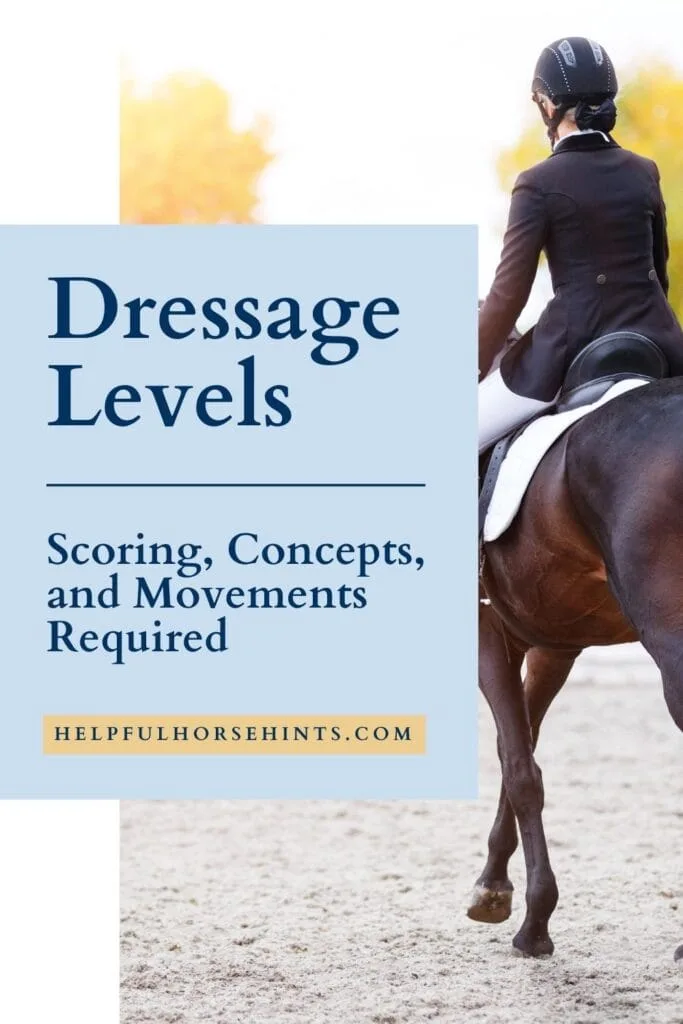
First Level (Novice)
Concepts Required: Rhythm, Relaxation, Connection, Impulsion
After a dressage horse can perform all of the basics of dressage as exhibited during the Training Level, he is ready to move up to the First Level. He is still expected to show proper rhythm, relaxation, and connection, and he also “has developed the thrust to achieve improved balance and throughness and to maintain a more consistent contact with the bit.”
Horses in the First Level have the appropriate power in their hindquarters (developed through training and competing at the Training Level) to begin focusing work on impulsion and straightness.
Aside from having pure gaits, the First Level dressage horse will also be asked to lengthen his strides. This is the early stage of developing proper impulsion and future collection.
Movements Required
- Free walk, medium walk, working trot, medium trot, working canter, halt and salute
- 15 and 20 meter circles, serpentines, diagonals, straight lines, half-circles
- Leg yielding, turning around the forehand, basic proper gait transitions
Second Level (Elementary)
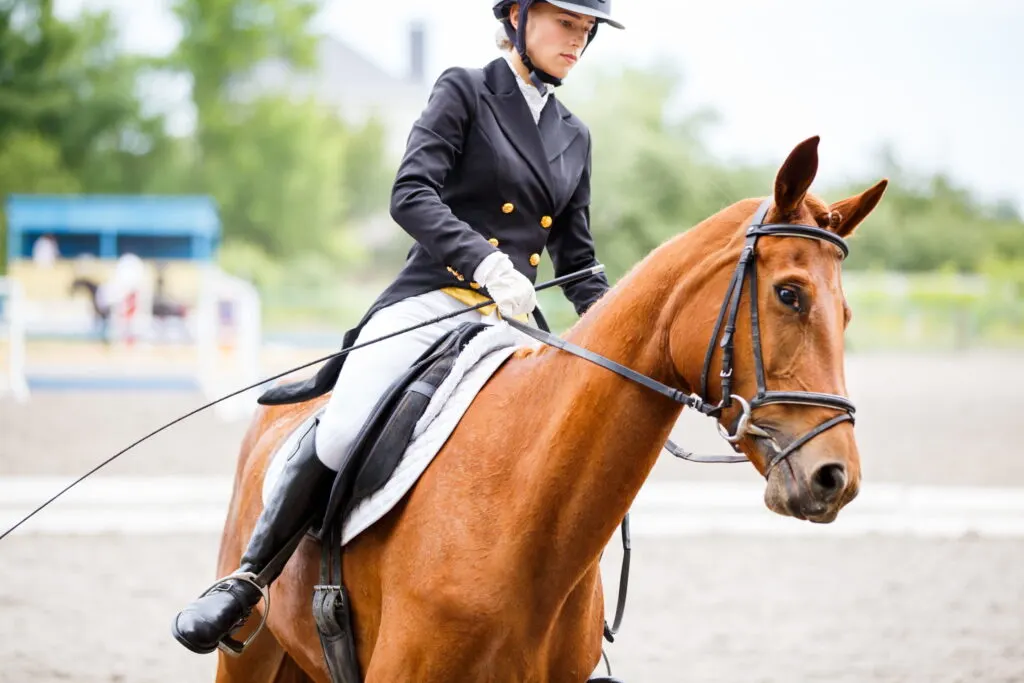
Concepts Required: Rhythm, Relaxation, Connection, Impulsion, Early Collection
The Second Level tests require “a greater degree of straightness, bending suppleness, throughness, balance and self-carriage.”
In dressage, a horse should always be straight.
This means that both sides of his body are moving evenly together, and that his muscles are developed properly on both sides. When working in a circle, his body should be aligned in a smooth arc all the way around.
The Second Level horse should also begin to show collection. This means that the horse is moving from the power in his hindquarters (impulsion), that he’s light and slightly elevated on the forehand, and he’s carrying himself well.
You can try to force collection by holding a horse’s head and neck up, but if his body hasn’t been adequately prepared – it’s a recipe for disaster.
Collection involves balance and strength in the whole body, and tests in the Second Level evaluate a horse’s skills in this area.
Ideally, horses should carry themselves as they move freely throughout the arena. Horses that must be “held up” artificially with devices or with a rider’s hands will not be as successful in dressage.
Movements Required
- Collected trot, medium trot, collected canter, medium canter, rein-back
- 8 and 10-meter circles, counter-canter, rein-back to collected trot
- Shoulder fore, travers and renvers, large half-pirouette at the walk
Third Level (Medium)
Concepts Required: Skills Necessary: Rhythm, Relaxation, Connection, Impulsion, Collection
By now, a dressage horse performing at the Third Level should have a good handle on all of the basic fundamentals of dressage. All of the elements from the pyramid of training work together to produce good quality gaits, and a great degree of collection and extension.
In the Third Level, more complicated maneuvers are also introduced. Horses must be able to transition well from extended to collected gaits, execute flying changes with balance, perform travers and renvers (haunches-in and haunches-out), and half-passes at trot and canter.
Movements Required
- Collected and extended walk, collected and extended trot, collected and extended canter
- Transitions from collected to medium gaits
- 6 and 20m canter circles, half-circles at counter-canter
- Shoulder-in, travers and renvers, 20 degree half-pass, walk pirouette
- Single flying lead changes
Fourth Level (Advanced)
Concepts Required: Rhythm, Relaxation, Connection, Impulsion, Full Collection, Advanced Movements (piaffe, passage)
This is the most advanced level of dressage, and it’s where you’ll see all the fancy “dancing” movements during an Olympic freestyle test. At the Advanced Level, horses must display all of the dressage fundamentals as introduced in previous levels – but with great precision and obedience.
Fourth level dressage horses must be light and elevated on the forehand, and often appear as though they are “floating” during certain exercises.
This floating effect is created by a great degree of strength and power from the horse’s hindquarters, and a deep intuitive connection between horse and rider. This is why top-level dressage horses often perform best with one rider, but are then unable to achieve the same levels of greatness with another.
Dressage is a true partnership between horse and rider, and dressage at the most advanced levels of competition is a reflection of that bond of horsemanship and training.
Movements Required
- All gaits working and collected, half-steps in trot, extended trot and canter, exceptional extended and collected canter
- Transitions from collected to extended (and back again) in walk, trot, and canter
- Counter-canter 10m half-circles
- 30-degree half-pass, counter change of hand in trot, half-pirouette in canter, many flying lead changes
- Advanced movements of piaffe and passage
Whether you’re thinking about introducing your horse to dressage, or you just want more information on the sport, the United States Dressage Federation and the FEI (International Equestrian Federation) have tons of information on their websites where you can find out more about the intricacies of dressage levels. Anyone can benefit from doing some dressage training with their horse, but it takes years to truly master the competition circuit and end up an Advanced Level champion!
Dressage Tests
In national dressage competitions in the US, there are five basic levels of dressage tests: Training, First, Second, Third, and Fourth. These are also referred to as Preliminary/Introductory, Novice, Elementary, Medium, and Advanced.
In international competition, the tests and levels are similar, but they have different names and slightly different requirements. International dressage competition levels are called Prix St. Georges, Intermediare I, Intermediare II, and Grand Prix. The advanced Grand Prix level is what you’d see at the Olympics, and it represents the very best of dressage.
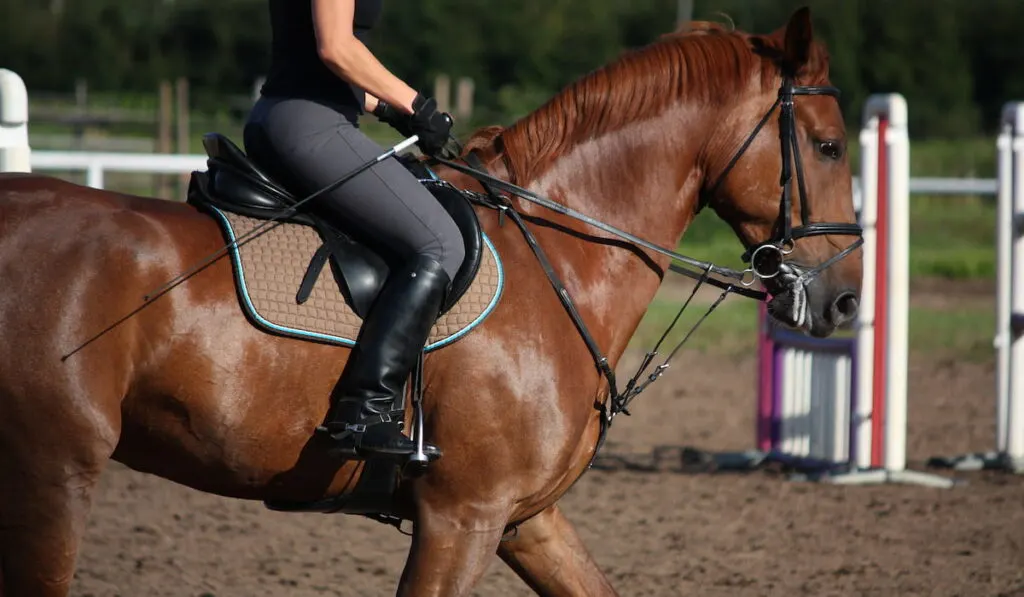
During a test, horses are judged on each individual movement with a score from 1-10. The rider also receives a collective score at the end of the test for the following categories: freedom and regularity of the gaits, proper impulsion, the horse’s submission, and the rider’s position, seat, and aids.
A score of 65% or better is generally a good sign that a horse is ready to move up to the next level.
Many people choose to train at a level or two above that in which they compete, and some people choose to compete just for the experience of it. Horses often act very differently in a strange competition arena than they do at home, where their surroundings are familiar and comfortable.
Generally speaking, you want your horse to be able to perform all the required movements with an appropriate degree of accuracy before moving up a level.
Beginner Tips + Practice Routines for Dressage
Dressage, often referred to as “horse ballet,” showcases the training and obedience of horses. But if you’re just starting out, it can be hard to see how it could ever be that flawless. Oh, and don’t be surprised if your horse gets a little foamy at the mouth when you’re training.
Tips for Beginners
- Choosing the Right Trainer: A suitable trainer is vital for beginners. Look for a trainer with experience, qualifications, and a teaching style that matches your learning preferences. Good chemistry and effective communication with your trainer enhance the learning experience.
- Basic Principles: Focus on rhythm, suppleness, balance, and collection. These principles are essential for creating a harmonious connection with the horse and performing movements with precision.
- Developing Effective Communication: Beginners must learn the correct seat, alignment, and use of aids to communicate effectively with their horse. This is crucial for achieving the desired movements in dressage.
- Equipment and Facilities: Use the right equipment, such as a dressage saddle, bridle, girth, reins, and whip, to facilitate proper positioning and communication. Practicing in a dressage arena with proper markings is also beneficial.
Practice Routines
- Walk Warm-Up: Begin with a walk warm-up to prepare the horse and rider for the first working set. This should take about 10 minutes, focusing on relaxation and mental readiness.
- Working Sets: Structure your practice into working sets. Each set should focus on specific movements or exercises, such as transitions between walk, trot, and canter, circles, serpentines, figure eights, half halts, and leg yields.
- Walk Breaks: Incorporate walk breaks between working sets. Use this time for the horse to catch its breath and for you to reflect on the ride’s progress and plan adjustments for the next set.
- Cool Down: End each session with a cool-down period, similar to the warm-up. This helps the horse to relax and recover, ensuring a positive end to the practice session.
These tips and routines are aimed at helping beginner dressage riders develop a strong foundation in dressage, focusing on communication, precision, and harmony with their horse.
Dressage Governing Bodies
These organizations are responsible for setting standards, organizing competitions, and promoting dressage at different levels—from local clubs to international championships. They ensure fair competition, and horse welfare, and help riders progress through various levels of the sport. Here’s a quick guide to the key organizations in dressage:
- Fédération Equestre Internationale (FEI): The international governing body for equestrian sports, including dressage. The FEI sets the global standards for competitions like the Olympics and defines the rules for international dressage events.
- United States Dressage Federation (USDF): The USDF is dedicated to the education, recognition, and promotion of dressage in the United States. It offers educational programs, organizes national competitions, and provides a framework for rider achievement.
- United States Equestrian Federation (USEF): As the national governing body for equestrian sports in the U.S., the USEF oversees a range of activities and ensures that national competitions adhere to both national and international rules.
- British Dressage (BD): This is the governing body for dressage in the UK. BD focuses on developing the sport at all levels, organizing competitions, and training riders to achieve international success.
- European Equestrian Federation (EEF): Although not exclusively focused on dressage, the EEF works to harmonize equestrian sports rules and standards across Europe and liaises with the FEI for international matters.
Resources/Related Reading
- https://en.wikipedia.org/wiki/Dressage
- Guide to Dressage Riding: Simple Explanations for a Complex Sport
- Best 7 Horse Breeds For Dressage
- Types of Dressage Saddle Pads
- https://dressagetoday.com/theory/how-to-use-the-dressage-pyramid-of-training/
- https://www.usdf.org/about/about-dressage/competition/tests.asp
- https://www.horsespeakeducation.com/beginners-dressage/#google_vignette
- https://dressagetoday.com/instruction/dressage-101-how-to-create-a-lesson-plan-for-each-training-session/
